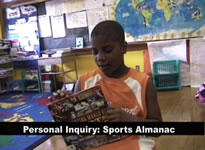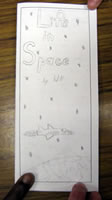 Almanacs and Inquiry:
Almanacs and Inquiry:
Personal Inquiries
As the class collected data and investigated resources for the school almanac, children also examined the almanacs for personal connections. Each student was given absolute choice over their personal inquiry topic. Their assignment was to focus on a topic they found interesting in an almanac.
Guiding through Questioning
While students could select a research topic of their choice, some needed guidance in developing questions, gathering data, analyzing information, and organizing their ideas.
As students began to think about creating their own almanac, Ms. K helped guide their thinking by asking some of the following questions:
- Is this question do-able... can we really get the data we need to create a graphic (chart, table, list) answer? Think about how the data could be collected and organized. Is it realistic?
- Is this question important enough to give the time to gathering data? Some surveys may be difficult to pull off, so we need to be realistic about time and who and what we can really ask. We also need to remember that some personal information is not possible, practical, or appropriate to gather.
- Is there some data already in place from which we can draw? For instance, is information for charts and tables such as teachers and their classes or rooms; teachers and the school from which they hold a degree; number of kids in each class, etc. available? Most of the content in almanacs comes from data already out there, but not organized by someone. It would be very expensive for publishers of an almanac such as the World Almanac to collect all the data themselves, so they draw heavily from what the government has already gathered. Keep in mind that government data is free to the public domain and thus inexpensive to work into a new table or chart.
- Is this question interesting and does it lend itself to some interesting illustrations? Think about your focus. Will your audience be excited about this information?
Almanacs and Personal Inquiry
 The children chose a wide range of topics that stressed across content areas including art, science, social histories, and sports.
The children chose a wide range of topics that stressed across content areas including art, science, social histories, and sports.
Many of the students latched onto particular almanacs and read them cover to cover, while others explored a variety of resources.
The almanacs were a great springboard, however many students sought out additional information through other books, websites, or interviews.
 View Personal Inquiry: Amazing Women (:14), Personal Inquiry: Sports Almanac (:17) and Personal Inquiry: Presidents (:51).
View Personal Inquiry: Amazing Women (:14), Personal Inquiry: Sports Almanac (:17) and Personal Inquiry: Presidents (:51).
Children describe the almanac that was the springboard for his or her personal inquiry.
Gathering and Recording Information
Students were asked to use two or more almanacs to find pertinent information. They also used information found on the Internet and sought library books to supplement their inquiry.
Students worked their way through the writing process. A wall-chart was used to help students keep track of their place in the writing process. Reminders were provided to help children remember skills such as use of punctuation and capital letters.

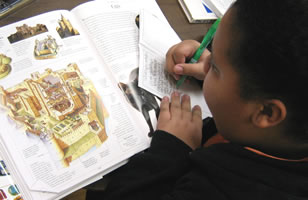
Creating a Product
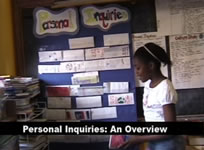 Having an authentic audience for a research project gives meaning to student work. Their goal was to create an informational brochure to organize their thinking and express their understanding of their topic. These documents became part of a class library for use during silent reading. Students could create more than one, however some students may only do one very detailed brochure.
Having an authentic audience for a research project gives meaning to student work. Their goal was to create an informational brochure to organize their thinking and express their understanding of their topic. These documents became part of a class library for use during silent reading. Students could create more than one, however some students may only do one very detailed brochure.
Each child sifted through information they gathered on their topic and created a three-panel brochure to share their facts. Sports records, famous American women, works of art, and space travel were a few of the topics selected.
Prior to building their brochures, Ms. K worked with the class to determine what makes a brochure successful. Children discussed the qualities of effective writing and presentation. It was hoped that this careful evaluation of presentation would carry over to the creation and design of the class almanac too.
 View Personal Inquiries: An Overview (1:12).
View Personal Inquiries: An Overview (1:12).
A child describes the personal inquiry project.
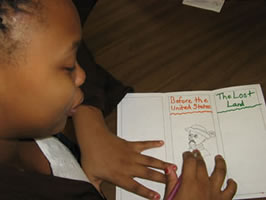
Working with Individual Differences
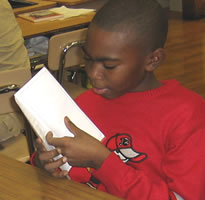 Whether working on the class almanac or conducting an individual investigation, each child is unique. One advantage of the inquiry approach is the opportunity for children to use their strengths and work on their weaknesses. Let's examine four students.
Whether working on the class almanac or conducting an individual investigation, each child is unique. One advantage of the inquiry approach is the opportunity for children to use their strengths and work on their weaknesses. Let's examine four students.
- Student 1 takes nonfiction seriously and is often a leader in building graphic projects. He's scanned or read nearly all of the 50 almanacs in the classroom.
- Student 2 is sharp, enthusiastic, and raises all the questions, but needs help to get a handle on how to answer them. Her hand is constantly in the air to raise a question, or to offer an answer (although nearly always wrong).
- Student 3 works in a concentrated manner until he finds answers. He's a loner and prefers the company of the teacher rather than other children. Often talking in numbers, nothing seems real to him unless a statistic is attached.
- Student 4 is amazed by history and latches onto the almanacs containing timelines. Anything that happened more than five years ago is news to him. He asks, are there any Kennedys who haven't been shot?
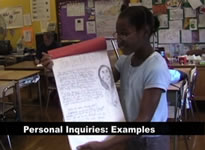 Each child took responsibility for their own inquiry.
Each child took responsibility for their own inquiry.
While some students focused most of their efforts on brochures, others created a book of posters with large illustrations.
 View Personal Inquiries: Examples (1:59).
View Personal Inquiries: Examples (1:59).
A child describes the personal inquiry projects.
Go to the Culture Study page to learn more about the next phase of the project.

